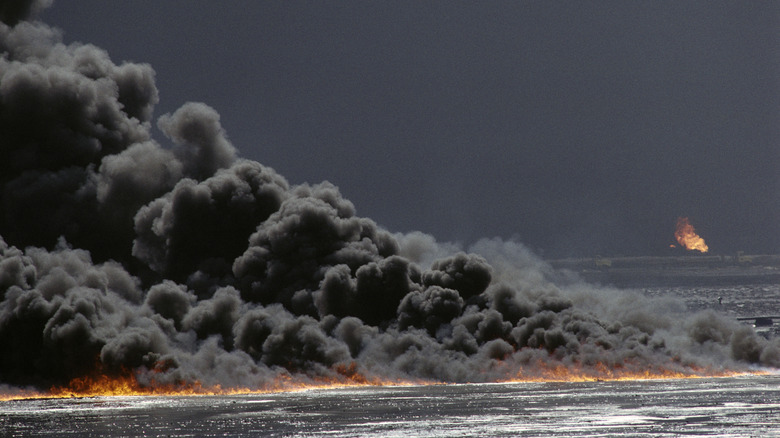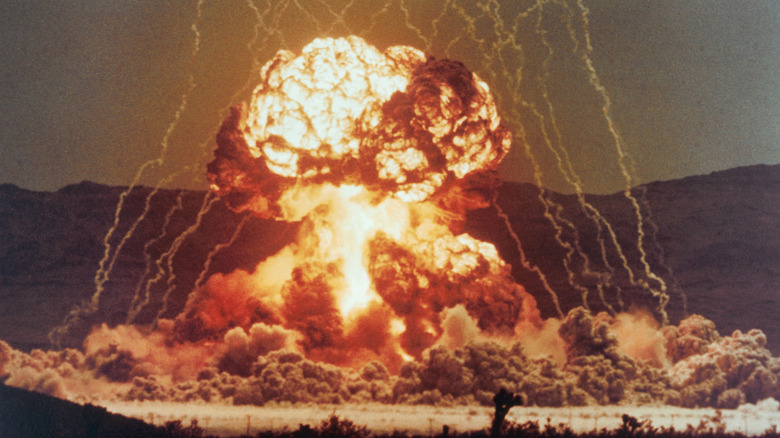Why The Soviet Military Nuked Their Own Gas Wells Multiple Times
The terms "nuclear explosions" and "peace" don't exactly sound alike. Yet, that's exactly what transpired merely a few decades ago, when the Soviet Union deployed nuclear weapons to extinguish oil well fires and stimulate gas production. The formerstate disclosed as many as 16 experimental and industrial explosions for construction purposes in fields such as petroleum, gas, minerals, and water resource development. But the concept was not unique to the Soviet Union, nor was it the first to the game.
In 1957, the U.S. government kicked off the Plowshare program for nuclear explosions in civil and industrial projects — an idea that first garnered attention following the famous "Atoms for Peace" speech by then-President Dwight D. Eisenhower. The whole exercise is broadly classified as peaceful uses of nuclear explosions (PNE), and between 1957 and 1973, the U.S. government conducted 27 nuclear tests for excavation projects, gas production, and production of rare isotopes. The objectives were not too different on the other side of the Atlantic.
Efrim. P. Slavskiy, an official in the Soviet nuclear program, championed the cause of PNEs. In 1965, when the state carried out a 140 kiloton nuclear explosion in Kazakhstan, Slavskiy was the first person to swim the lake formed in the crater created by the event. A year later, the idea of using nuclear explosions for extinguishing runaway gas wells was proposed in the wake of an industry-wide crisis. In just a year, numerous successful operations were carried out to close wells.
It was the start of explosive success
The first documented PNE event for extinguishing gas wells was the Urtabulak gas field in Southern Uzbekistan. In 1963, at a depth of nearly 2.5 km, control of well number 11 was lost, leading to 12 million cubic meters of leaked gas per day — volume enough to power a massive city like St. Petersburg.
For three years, experts struggled to contain it. All the attempts to control the leak failed because the bottom segment spanning roughly a thousand meters could not be plugged. Attempts to divert the flow also failed due to safety concerns. Finally, in 1966, the idea of using a nuclear explosion moved forward. Two holes of 13.5-inch diameter were drilled, and one of them reached a depth of around 1.5 kilometers, while its distance from the leaking well was estimated to be around 35 meters. The Soviet Union performed four successful explosions between 1972 and 1981.
The first course of action was to cool down the artificial hole so that the nuclear explosive could be safely placed inside. After the explosive was placed inside the chamber, it was sealed with cement to prevent radiation from contaminating the atmosphere. In September of 1966, a 30-kiloton nuclear explosive was detonated in the artificial well. "Twenty-three seconds later the flame went out and the well was sealed," says a DOE report.
Success stories in the later years
Merely a few months after the Utrtabulak success, a similar strategy was executed in the Pamuk gas field. After drilling to a depth of roughly 2.7 kilometers, the operational team ran into a blockage at a depth of 800-1000 meters due to a runaway well, and soon, gas started leaking through the surface, too. When solutions such as hydraulic fracking failed, it was decided that a nuclear explosion would again be deployed. Subsequently, an inclined hole was drilled to a depth of 2.4 kilometers, reaching roughly 30 meters in the vicinity of the leaky well.
A specialized nuclear device that could withstand the high pressure and temperature was developed at the nuclear weapons laboratory in Chelyabinsk, the site of a destructive meteor strike in 2013. Measuring two meters in length, the 47-kiloton nuclear device was detonated in 1968 and helped seal the gas leak within a week. According to the World Nuclear Association, except for one, every nuclear operation carried out by the Soviet Union to extinguish fire and seal off leaking wells was a success.
The last such operation carried out in the Kumzhinskiy gas deposit in 1981 failed its objective. On the positive side, all the PNE projects for extinguishing and sealing runaway gas wells were safely contained and there were no reports of radioactivity on the ground level, which would otherwise threaten nuclear survival. In 2010, the idea of a nuclear explosion to contain the massive Deepwater Horizon oil spill in the Gulf of Mexico was proposed, but the US government rejected the idea.


